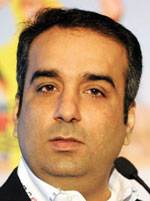SaS Technology has been designed purely for business analytics use with seamless integration with clients’ business IT applications.
 By Ravi Makhija,
By Ravi Makhija,
Chief Operating Officer, SaS
Data has been transformed to information and to intelligence and different applications related to it for effective governance. Over the last eighty years we have organised from knowledge in the mind to knowledge in the books to internet. The question arises how to turn data into some kind of information and eventually into intelligence.

There can be various questions and differences related to data like what kind of data, why and when did it happen, how much of it has happened, where will it happen, what is it that is going to happen, and what if the trend continues to happen. This primarily is the difference between business intelligence and analytics.
Local governments and organisations try to understand what is historic and is happening and so on. But not many of them are trying to get into the next level which is the predicting part.

In case of land reforms, property and registrations are the key elements to identify land and property names and addresses. This will help in data adjudication layer.
 Next is analytics layer followed by reporting. Business solutions specifically to government, like what we have is and what can urban governance do with lot of intelligence applications, are related to essentially improving citizen centricity.
Next is analytics layer followed by reporting. Business solutions specifically to government, like what we have is and what can urban governance do with lot of intelligence applications, are related to essentially improving citizen centricity.
Next is increasing revenue and reducing operating cost, optimizing operations, smart grids and how we can ensure that we have enough power supply.
We need to have the ablity to maintain continuous supply and ensure that there is no fluctuation in supply. Then there is cyber policing and tax fraud management.
In health sector smart applications have been implemented. Aarogyashree in Andhra Pradesh has been implemented and SaS is trying to understand how exactly the programme has been implemented in terms of reach and performance.
Third step is trying to predict what is required in terms of infrastructure and manpower to address the growing concerns of health related issues in Andhra Pradesh. When the hospitals were filing the claims for reimbursements of cashless schemes it was found that certain hospitals were filing claims which they were not eligible for. So they cut off those hospitals from the list of approved hospitals.
Taxation is one of the key areas for adoption of analytics. There are close to 85 installations of taxation across the globe. The concerns are related to low filing, zero filing and nonpayment, and claiming VAT when one is actually not eligible to claim it. So pilot programme was implemented in two states. One simplistic rule that pilot followed is to correlate tax returns with consumption of electricity.
In terms of public safety, analytics can help in putting in place information-led policing, intelligence led investigation and social network analysis. If implemented well, this can help identify possible causes of threat in advance. A person while using social media leaves social footprint which can be analysed to try and predict the behavior leading to threat.
In India we are on the verge of creating fusion centre which is going to help in deriving more intelligence out of 21 databases where people leave some kind of data in normal day to day activity. In this way, day to day work can be done much better with analytics.
Be a part of Elets Collaborative Initiatives. Join Us for Upcoming Events and explore business opportunities. Like us on Facebook , connect with us on LinkedIn and follow us on Twitter, Instagram.











